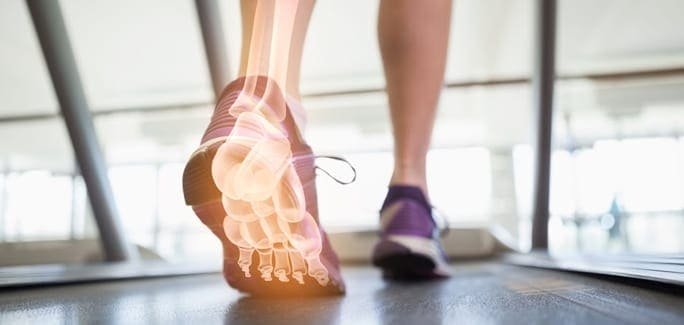For athletes, runners and fitness enthusiasts, nothing is worse than foot pain that keeps you from participating in the activities you love. In many cases, foot pain goes away with sufficient rest and a change of shoes. But when you have lingering pain in the arch or your foot, it could signal a serious condition that may worsen over time, leading to injury or disability.
Your feet are designed to walk, run, jump and stabilize your body when standing and moving. They provide important feedback to your brain about your body’s position relative to gravity, and respond to disruptions in balance by redistributing your weight. Despite their ability to withstand high force loads, even the strongest feet can succumb to repetitive overuse.
Foot anatomy can be understood in terms of three subsystems:
- Passive subsystem: consisting of the bones of the arches, the plantar fascia that spans the foot bottom, and the ligaments that connect the bones to one another.
- Active subsystem: includes the intrinsic foot muscles that act as stabilizers, and the extrinsic foot muscles that act as global movers.
- Neural subsystem: includes local and global musculotendinous receptors, ligamentous receptors, including the plantar fascia; and plantar cutaneous receptors.
All three subsystems interact to provide stability and enable the foot to adapt to the ever-changing demands of physical activity.
Ongoing pain in the arch of the foot can originate from a number of conditions. Some common causes of foot arch pain include:
- Cavus foot: People with genetically high arches due may be more prone to arch pain. High arches sometime cause other issues, like calluses on the ball of the foot. hammer toe (deformity of the second, third or fourth toe), and claw toe (where the toes curl in like claws). Strengthening the intrinsic foot muscles can help prevent arch pain in people with high arches.
- Dysfunction of the Posterior Tibial Tendon: Your posterior tibial tendon attaches your calf muscle to the bones on the inside of your foot, helping to support your foot arch when walking. If the tendon becomes inflamed or injured, it may no longer be able to provide arch support, causing inner arch foot pain. Physical therapy can help restore tibial tendon function and promote healthy arch support.
- Overpronation: Your foot may overpronate if you strike with the outer edge of your heel and your foot rolls inward onto the arch, causing the foot to flatten. If left uncorrected, overpronation can lead to arch pain and structural damage. Over time, the tendency to overpronate can lead to pain and dysfunction in your knees, hips and low back. Gait retraining and targeted exercises can correct overpronation. Pregnancy or obesity can increase your tendency to overpronate.
- Plantar fasciitis: The thick ligamentous band that spans the bottom of your foot to connect your heel to your toes, called the plantar fascia, can become inflamed or torn. Although plantar fasciitis most often appears as heel pain, pain can spread throughout the plantar fascia, leading to a sharp pain in the arch of the foot. Physical therapy, including extracorporeal shock wave therapy (ESWT) is the fastest route to resolving plantar fasciitis.
There are some rare conditions that cause pain in the arch of the foot that are easily overlooked:
– Plantar fibroma occurs when a small nodule located in the plantar fascia causes pain during walking. This condition can be diagnosed with high frequency diagnostic ultrasonography. Occasionally, if the fibroma is large, this painful nodule can be palpated on the bottom of your foot.
– Master Knot of Henry syndrome is caused by inflammation due to excessive friction at the intersection of the FDL and FHL tendons, near the navicular bone. This can irritate the nearby medial plantar nerve and cause stabbing pain in the arch of the foot, as well as numbness and tingling.
– Tendinosis of the peroneus longus and tibialis anterior tendons. When irritated, these tendons infrequently cause arch pain.
If you are suffering ongoing arch pain, do not ignore it. The foot pain specialists at NYDNR use diagnostic real-time ultrasound to accurately diagnose the underlying cause of arch pain, which enables them to quickly devise a targeted heel pain treatment plan.
Treatment strategies may include:
At NYDNR, we combine professional expertise with innovative therapies and state-of-the-art technologies to provide our patients with the very best care for rehabilitation of foot arch pain.























































